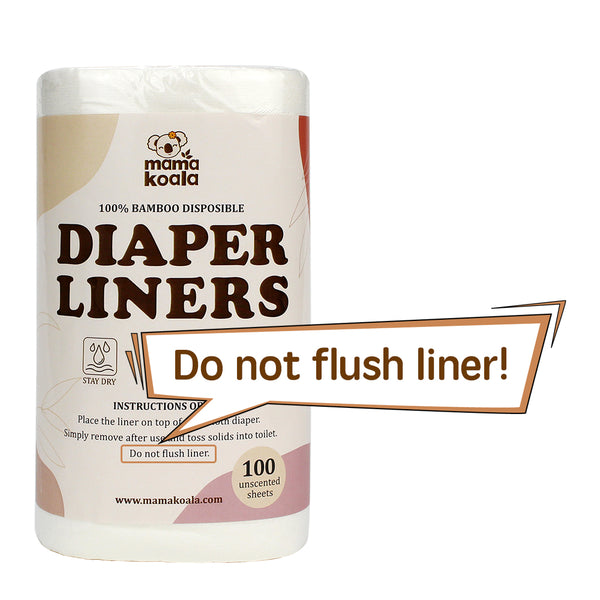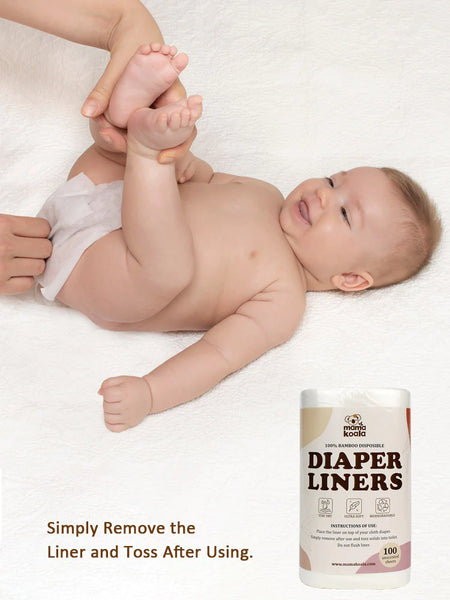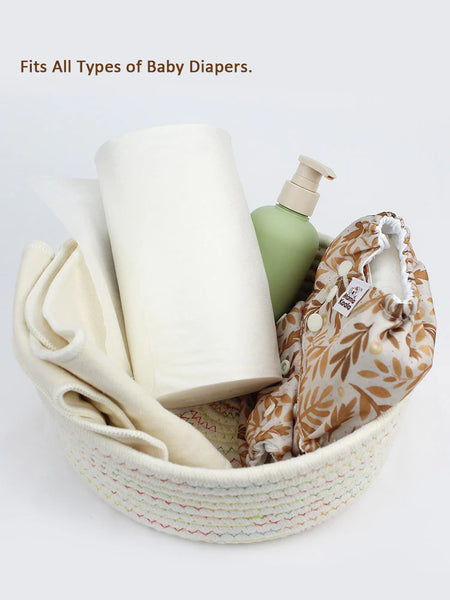About Cloth Diaper Liners
A cloth diaper liner is a thin layer of material that is placed between the baby's skin and the cloth diaper. It’s not meant to absorb any liquid, but it is an essential tool for simplifying clean-up or protecting your cloth diapers from diaper cream/bum cream. In this blog post, we will explore the benefits of using a diaper liner and explain how it can make your life easier.
Types of Cloth Diaper Liners
Disposable diaper liners: They are thin sheets that can be placed on top of a cloth diaper to catch solid waste. They are typically made of biodegradable materials and can be easily disposed of after use. They are a convenient option for many families, especially when you're on the go or traveling. You can simply remove the liner with the waste and throw it in the garbage. They are also great for parents who don't have access to a washing machine or prefer not to deal with the extra laundry.
Important Note:
Most disposable diaper liners are marketed as “flushable” or “septic-safe", but we do not recommend flashing them down the toilet. Even though they will finally break down, compared to toilet paper, they take much more time to do so. Subsequently, they will clog sewers and pipes, cause backups and overflows at wastewater treatment facilities, and create an additional public health risk.

Reusable diaper liners: They are washable and can be used multiple times. They are usually made of soft and washable materials such as bamboo or fleece. Reusable liners are placed on top of the cloth diaper and can be easily removed for cleaning. They are cost-effective because you only need to buy them once and can reuse them over and over again. They are also better for the environment, as they reduce the amount of waste going to landfills.
How To Use Cloth Diaper Liners?
Using cloth diaper liners is simple and straightforward. Here's a step-by-step guide:
🍧Place the cloth diaper liner on top of the cloth diaper, ensuring that it covers the entire diaper area.
🍧Fasten the cloth diaper on your baby as you normally would.Make sure the liner staysin place.
🍧When it's time to change the cloth diaper, remove the liner and throw it into the trash.For a reusable cloth diaper liner, after removing the solid waste on it, you can store or wash it together with your cloth diapers and accessories.
🍧Clean the cloth diaper as per the manufacturer's instructions.
Important Note:
If you’re using a diaper cream/bum cream that’s not safe for cloth diapers (containing zinc or petroleum), we don’t recommend washing your reusable liner with cloth diapers. Or the cream will plug into your cloth diapers and cause repelling/leaking issues.

What Are The Benefits Of Using A Cloth Diaper Liner?
Using a cloth diaper liner offers several benefits for both parents and babies:
Keeps baby dry: The liner helps to wick away moisture from your baby's skin, lets liquid pass through, and keeps your baby dry and comfortable.
Easier cleanup: When it's time to change the cloth diaper, the liner will catch the solid waste and can be easily removed or washed out, making cleanup a breeze.
Protect your cloth diaper: The liner acts as a barrier to protect your cloth diapers from diaper balms and creams, preventing stains and making it easier to wash them out.
Reduces diaper rash: By keeping the baby's skin dry, cloth diaper liners can help reduce the occurrence of diaper rash.
Disposable Or Reusable, Which Is Better?
There is no definitive answer to which type of diaper liner is better. It ultimately depends on your individual circumstances and preferences. If convenience is a top priority for you, disposable diaper liners may be the better choice. On the other hand, if you're looking to save money and reduce your environmental impact, reusable diaper liners are a great option.
It's worth noting that some parents choose to use a combination of both disposable and reusable liners. They may use disposable liners when they're out and about, and reusable liners at home. This allows for flexibility and convenience while still being mindful of the environment.
Important Note:
When selecting a cloth diaper liner, you may also take the following 2 factors into consideration:
Material: If your baby is sensitive to wetness, you could try the liners of stay-dry fabrics, such as fleece or AWJ. On the other hand, if the synthetic material irritates your baby’s skin, you can choose the natural cloth diaper liners, such as bamboo ones.
Size: Make sure the liner is the right size to fit inside your cloth diaper.

Tips & Tricks
💡 We do not recommend using disposable baby wipes as cloth diaper liners because they are pre-wetted in solutions, which will increase the risk of diaper rashes or irritations, especially touching your baby’s skin for a long period of time.
💡 Paper towels are not a good replacement for cloth diaper liners because they will break easily (especially after pee or poo) and will leave some bits.
💡 For each diaper change, we recommend using one piece of diaper liner. Cloth diaper liners are not inserts, so using more liners won’t help a lot in increasing absorbency. On the contrary, using more liners on top of your cloth diaper might prevent it from absorbing liquid quickly, and then cause leaking issues.
In conclusion, cloth diaper liners are not a much-have in your cloth diapering journey, but they will make it easier to clean and protect your cloth diapers. When deciding between disposable diaper liners and reusable ones, consider your lifestyle, budget, environmental concerns, etc. Whichever option you choose, the most important thing is to keep your baby clean, comfortable, and happy!


